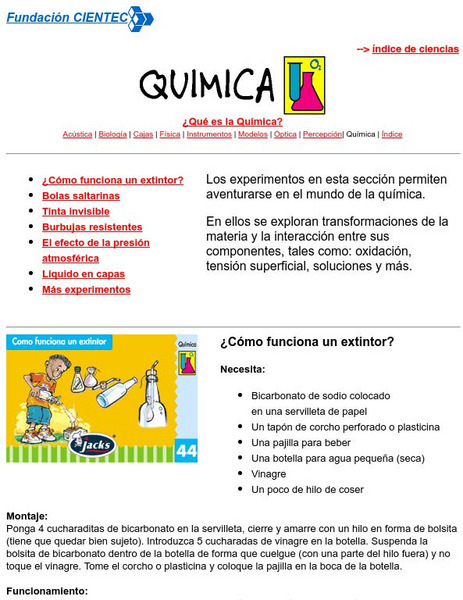Dartmouth College
Dartmouth College: Qualitative Analysis of Anions
"In this experiment, you will observe the reactions of some simple salts, analyze common household chemicals, and identify an unknown sample by testing its reactivity."
Dartmouth College
Dartmouth College: Chem Lab: Titration
A titration is a method of analysis that will allow you to determine the precise endpoint of a reaction and therefore the precise quantity of reactant in the titration flask. This site demonstrates how to correctly perform this analysis.
Dartmouth College
Dartmouth College: Chem Lab: Natural Salt Solutions 1: Ion Exchange
In this experiment, you will concentrate on understanding the chemistry of ion exchange and estimate the capacity of an ion exchange column from your observations.
Dartmouth College
Dartmouth College: Acids, Bases, and Buffers 1: Monoprotic and Polyprotic Acids
In this experiment, you will explore the behavior of the monoprotic acid (acetic acid) and the polyprotic acid (phosphoric acid). By titrating, you will examine the acid and conjugate base species present across the pH scale and the...
Dartmouth College
Dartmouth College: Chem Lab: Chemical Kinetics 1
In this experiment, you will determine the rate law and confirm the mechanism of the reaction between cyclohexanone and iodine. Requires Java and QuickTime plug-ins to access some features.
Dartmouth College
Dartmouth College: Chem Lab: Chemical Kinetics 2
This lab further analyzes the results of the experiments carried out in Chemical Kinetics 1. In addition, you will carry out experiments to determine the temperature dependence of the reaction rate constant. Requires Java plug-in.
Dartmouth College
Dartmouth College: Chem Lab: Spectrum of the Hydrogen Atom
In this experiment, you will use a meterstick spectroscope to observe the emission spectrums of hydrogen, sodium, neon, helium, and mercury. Requires Java plug-in.
Dartmouth College
Dartmouth College: Chem Lab: Spectra of Conjugated Dyes & Beer's Law
In the first part of this lab, you will measure the absorption spectra of two conjugated dyes and compare the results to the theoretical predictions of a particle-in-a-box model. In the second part of the experiment, you will identify...
Dartmouth College
Dartmouth College: Chem Lab: Coordination Chemistry 3.2
In this experiment, you will study the reaction between your cobalt complex and the nitrite ion. The nitrite ion can exchange with a water ligand and the mechanism of this ligand exchange will be investigated. Requires Java plug-in.
Dartmouth College
Dartmouth College: Chem Lab: Coordination Chemistry: Kinetics of Ligand Exchange
In this experiment, you will complete the study of the mechanism of ligand exchange. The reaction will be followed colorimetrically and the rates of exchange and ligand isomerization will be measured. Requires Java plug-in.
Dartmouth College
Dartmouth College: Chem Lab: Coordination Chemistry 3.1: Acid/base Analysis
In this experiment, you will examine the acidity of your coordination complex's water ligand. You will determine the acid dissociation constant of the complex by titrating it with a base. There are eight weeks of experiments in this series.
Chemistry Collective
Chem Collective: Virtual Lab
Perform virtual lab experiments safely. Pour and mix specific amounts of various solutions on screen and observe changes in temperature and pH. Choose glassware and other tools (ie. bunsen burner, scale) to assist with virtual lab...
Exploratorium
Exploratorium: Science Snacks: Snacks From a Z
Here is a monumental list of ideas for science fair projects and experiments, organized alphabetically. Every one of them is a link to a full page, with pictures, of information about the idea. This site is a goldmine.
NBC
Nbc Learn: Chance Discoveries: Lab Experiments, Unexpected Results
Many (if not most) experiments in the chemistry lab do not get significant results - or the expected results. In this Chemistry Now original video series, we highlight the curiosity, daring, and creativity of the best bench chemists by...
Dartmouth College
Dartmouth College: Centrifugation
"A centrifuge separates a heterogeneous mixture of solid and liquid by spinning it." Use this site to find out how to correctly use a centrifuge in this informative site.
Dartmouth College
Dartmouth College: Chem Lab: Vacuum Filtration
Vacuum filtration is a technique for separating a solid product from a solvent or liquid reaction mixture. This comprehensive site addresses setting up and performing vacuum filtration.
Dartmouth College
Dartmouth College: Chem Lab: Quantitative Transfer
A Quantitative Transfer simply means that all the material to be transfered from one place to another must make the trip, down to the last particle. Use this site to find out how to correctly transfer a solid and a liquid.
Royal Society of Chemistry
Royal Society of Chemistry: Kitchen Chemistry: Salt and the Boiling Point [Pdf]
An experiment where students test how the boiling point of water is affected by adding salt. The experiment is well laid out with pictures that show how to perform the experiment.
Fundación Cientec
Cientec: Quimica
Simple step by step experiments that will allow students to venture in the world of Chemistry. Students can explore transformations of matter and interactions among its components, such as oxidation, surface tension, solutions and more.






